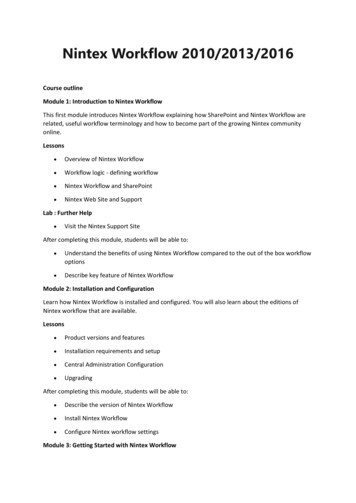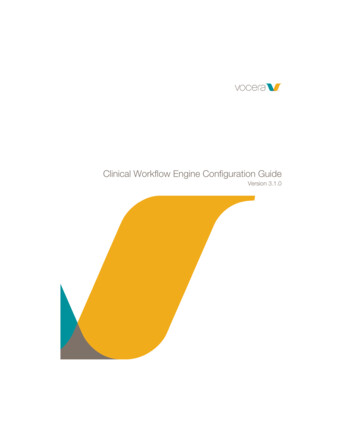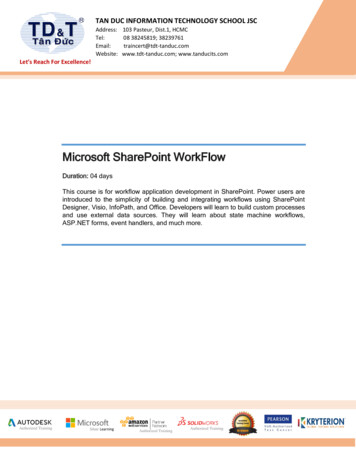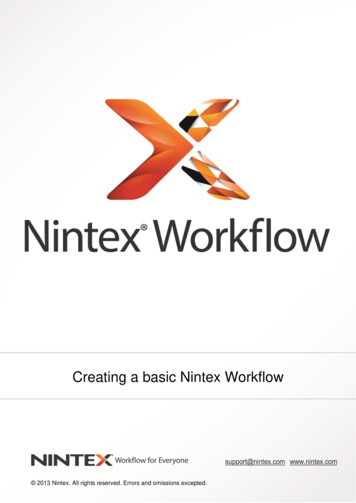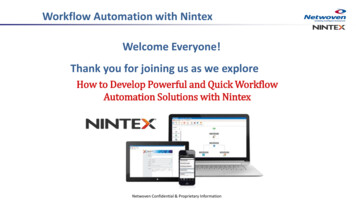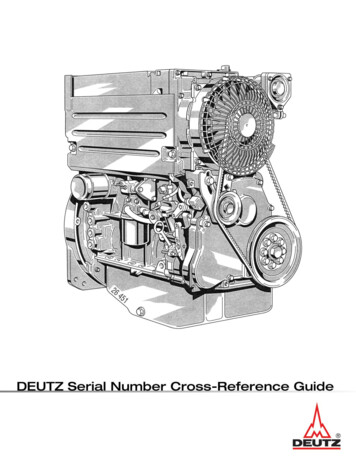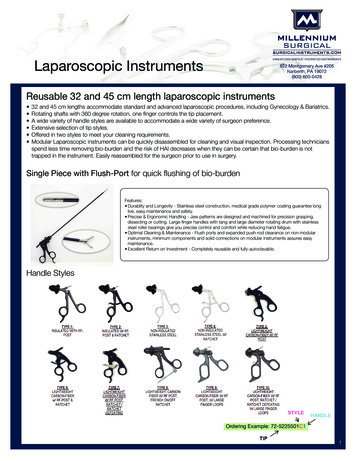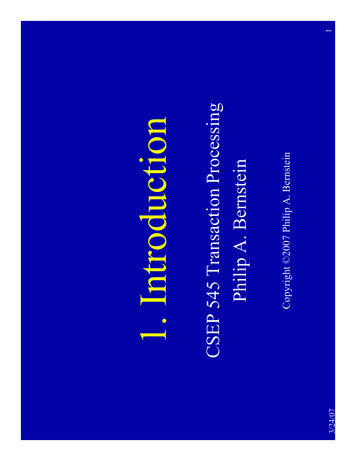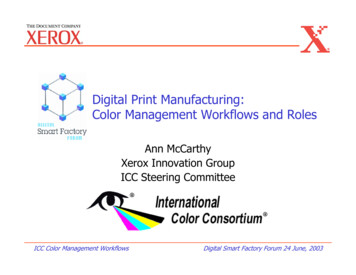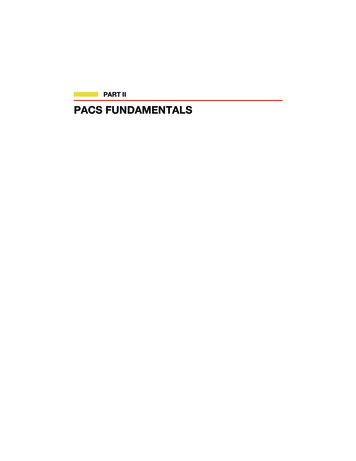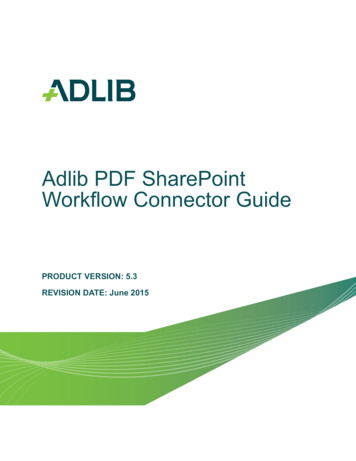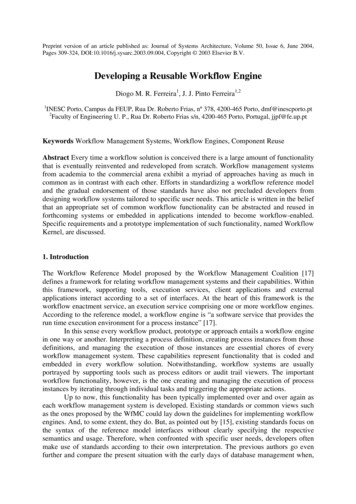
Transcription
Preprint version of an article published as: Journal of Systems Architecture, Volume 50, Issue 6, June 2004,Pages 309-324, DOI:10.1016/j.sysarc.2003.09.004, Copyright 2003 Elsevier B.V.Developing a Reusable Workflow EngineDiogo M. R. Ferreira1, J. J. Pinto Ferreira1,21INESC Porto, Campus da FEUP, Rua Dr. Roberto Frias, nº 378, 4200-465 Porto, dmf@inescporto.pt2Faculty of Engineering U. P., Rua Dr. Roberto Frias s/n, 4200-465 Porto, Portugal, jjpf@fe.up.ptKeywords Workflow Management Systems, Workflow Engines, Component ReuseAbstract Every time a workflow solution is conceived there is a large amount of functionalitythat is eventually reinvented and redeveloped from scratch. Workflow management systemsfrom academia to the commercial arena exhibit a myriad of approaches having as much incommon as in contrast with each other. Efforts in standardizing a workflow reference modeland the gradual endorsement of those standards have also not precluded developers fromdesigning workflow systems tailored to specific user needs. This article is written in the beliefthat an appropriate set of common workflow functionality can be abstracted and reused inforthcoming systems or embedded in applications intended to become workflow-enabled.Specific requirements and a prototype implementation of such functionality, named WorkflowKernel, are discussed.1. IntroductionThe Workflow Reference Model proposed by the Workflow Management Coalition [17]defines a framework for relating workflow management systems and their capabilities. Withinthis framework, supporting tools, execution services, client applications and externalapplications interact according to a set of interfaces. At the heart of this framework is theworkflow enactment service, an execution service comprising one or more workflow engines.According to the reference model, a workflow engine is “a software service that provides therun time execution environment for a process instance” [17].In this sense every workflow product, prototype or approach entails a workflow enginein one way or another. Interpreting a process definition, creating process instances from thosedefinitions, and managing the execution of those instances are essential chores of everyworkflow management system. These capabilities represent functionality that is coded andembedded in every workflow solution. Notwithstanding, workflow systems are usuallyportrayed by supporting tools such as process editors or audit trail viewers. The importantworkflow functionality, however, is the one creating and managing the execution of processinstances by iterating through individual tasks and triggering the appropriate actions.Up to now, this functionality has been typically implemented over and over again aseach workflow management system is developed. Existing standards or common views suchas the ones proposed by the WfMC could lay down the guidelines for implementing workflowengines. And, to some extent, they do. But, as pointed out by [15], existing standards focus onthe syntax of the reference model interfaces without clearly specifying the respectivesemantics and usage. Therefore, when confronted with specific user needs, developers oftenmake use of standards according to their own interpretation. The previous authors go evenfurther and compare the present situation with the early days of database management when,
in the absence of the relational and entity-relationship models, an incongruous set of databasesolutions coexisted.In this respect, this article argues, as other authors have done, that Petri Net theorycould become to workflow management what the relational model became to databasemanagement. It is also argued that a reasonable amount of common workflow functionalitycan be abstracted from existing approaches, and that from this abstraction it is possible todevelop a Workflow Kernel that can be reused and embedded in workflow-enabled systemsand applications, so as to prevent repeated and discordant implementations of generalworkflow features.2. Common approaches and reusabilitySuccessful workflow products such as Staffware , InConcert , or FlowMark are anelaborate compound of user requirements. Throughout the years these and other leadingproducts have been improved in order to fulfill or anticipate particular user needs. Butalthough they share the common goal of business process integration, each product displaysits own philosophy and approach. From the event-driven process chains (EPC) of ARIS Toolset [12] to the four-stage workflow loop of ActionWorkflow [8] there are severalapproaches to workflow management. Many workflow solutions are built on a set ofconstructs that are believed to be appropriate to describe business processes. Staffware hasits own constructs for modeling business processes, InConcert has another set of constructs,and ARIS and ActionWorkflow have their own constructs too.Furthermore, every product provides a process editor to graphically define or modifyprocesses, provides support for monitoring process instances, and client applications tomanage individual tasks. These support tools, which are the front-end of the workflowsolution, are the functionality most seen by the user, and take a significant effort to develop.Still, behind this front-end each one of these solutions contains an engine capable ofinterpreting the process definition language, creating process instances from processdefinitions, and controlling the execution of these instances. Regardless of productphilosophy, what lies in the heart of each workflow solution is an engine that glues everythingtogether and makes the desired orchestration possible.The WfMC’s Workflow Reference Model describes the purpose of a workflow engineby a set of features that it is supposed to address. But then, if these features are well knownand in fact provided by each workflow solution, why not isolate that functionality in acomponent that can be plugged in or embedded in every workflow application? Someproposals have been brought up as an answer to this question.2.1. The Drala Workflow EngineThe Drala Workflow Engine [5] is an embeddable Java component that provides acomprehensive API for defining, executing and monitoring processes. It is not a workflowmanagement system by itself; it is rather a core of workflow functionality which is intended tosimplify the implementation of workflow management systems. The Drala Workflow Enginealready includes some support tools such as a process editor, but it allows developers toreplace these tools or to build additional user interfaces. Process definitions can be importedand exported in an XML format, and the Drala Workflow Engine supports the exchange ofXML data between software applications built on top of that engine.
2.2. The Workflow ToolkitThe open-source Workflow Toolkit known as “wftk” [16] is an open-source project that isdeveloping a function library (in ANSI C) to provide Web-based applications with workflowbehavior. The wftk toolkit has two main components: the workflow core, which controlsprocess and activity execution, and the repository manager, which stores and retrieves datafor workflow activities. Both of these components rely on adaptors in order to interact withexternal systems, including databases, Web servers and third-party data formats such asprocess definition languages. Basically, an adaptor translates an external data format into aformat that wftk is able to handle. Internally, the wftk manipulates objects represented byXML streams: processes, tasks, users, are all represented as XML strings. For example, aprocess is represented as a special type of XML format called a datasheet, which is acontainer for other XML objects. A process is also a single-threaded queue of tasks, whichwaits for the completion of each task to proceed to the next one.2.3. The WorkMovr APIThe WorkMovr API from A-Frame Software [3] is a complete, Java-based programmingframework for workflow management systems. In fact, WorkMovr is a workflowmanagement system by itself, and its entire functionality is accessible via external interfaces,which is called the WorkMovr API. The WorkMovr architecture has five layers: the DataAccess Layer is the closest to the underlying database system; the Data Management Layerimplements enhanced data manipulation routines; the Table API hides the details of theparticular database schema, expressing it through a set of high-level Java objects; theWorkflow API provides access to the internal workflow engine, which manages work queues;and the Web Management Layer can be used to implement Web-based front-ends. Each layerincorporates and builds upon the functionality of the preceding layer. The key feature is that itis possible to develop external applications that interface with the WorkMovr system directlyat any of these layers.2.4. Fujitsu’s i-Flow The i-Flow from Fujitsu Software Corporation [6] is a Java-based workflow product thatpromotes reusability of all of its features. The product is sold as a package with source codeincluded, and it can be used as-is (as an out-of-the-box solution), it can be customized tospecific user requirements, or it can be used to build new workflow solutions. The i-FlowServer is a workflow engine that interacts with external resources such as file systems,directory services, databases, and e-mail servers by means of application wrappers calledintegration adapters. The engine can also be integrated with existing systems through ascripting language (JavaScript). i-Flow comes with a set of reference clients, which provideWeb-based GUIs to define processes and administer the server, but it is possible to developcustomized clients according to specific user needs, either built from scratch using theprovided APIs or built as a functionality extension to any of the provided reference clients.3. Guiding principlesThe problem with current approaches towards reusability is that they aim at a full-fledged, allencompassing set of workflow functionality, including process modeling, applicationwrappers and client applications. Instead, however, a reusable workflow engine should focus
exclusively on providing process execution capabilities, leaving all of the remainingfunctionality up to the implementation of a particular workflow management system. Thisshift towards a narrower focus is illustrated in figure 1, which depicts the WorkflowReference Model as defined by the WfMC. The purpose of developing a reusable workflowengine is to allow subsequent workflow management systems to be developed by plugging theappropriate functionality or components into that engine. From this it follows that a reusableworkflow engine must be designed in a way that is independent of (1) particular modeling andmonitoring tools, (2) particular ways of interacting with resources, and (3) particular ways ofinteroperating with other workflow enactment services.Figure 1. Narrowing the scope of reusability3.1. The process representation languageMany workflow management systems devise their own process modeling language that seemsappropriate for specific user needs, but is not backed by any formalism that can ascertain itsproperties or suitability. But a workflow engine that is intended to be reusable must make useof formal semantics in order to specify processes unambiguously and consistently, and toallow rigorous workflow analysis techniques to be employed. The main advantage is that ifthe workflow engine makes use of formal semantics then all workflow management systemsbased on this workflow engine will be able to rely on those semantics rather than developingproprietary modeling languages. It will then be possible to take advantage of formal analysistechniques to study the behavior of workflow processes. These analysis capabilities may beprovided by the workflow engine itself, or by external components.Realizing the need for a formal language, several authors have encouraged the use ofPetri nets [4] for process modeling. The application of Petri nets to workflow management hasseveral advantages [1]: Petri nets have formal semantics to describe workflow processes in a clear andprecise way, and they also have an intuitive, graphical nature which is easy for end-users tograsp. Petri nets include basic constructs which can be used as building blocks to specifyprocess definitions, and they also include a set of enhancements, such as color and time,which have a formal representation. Furthermore, Petri nets can even be used to definehigher-level process modeling languages [2], if necessary. Petri nets have a solid mathematical foundation supported by decades of research.Several properties of Petri nets have been investigated, and many analysis techniques areavailable. These techniques can be employed to check process models for inconsistencies,such as deadlocks or infinite loops, and to compute performance measures, such as executiontimes and resource utilization. This way it is possible to evaluate alternative process models. Petri nets are a vendor-independent formalism to describe and analyze workflowprocesses. They are not based on a specific product or technology, and they are not affected
by product changes or upgrades. Besides, information on Petri nets is available fromindependent sources, and research on Petri nets will proceed regardless of any particularworkflow management system.3.2. Resource invocationMany workflow management systems assume specific ways of interacting with resources anddo not consider that, in an enterprise-wide environment, they may be required to interact witha variety of resources, from human to different systems, applications, or even machines. Eachresource may require a different kind of interaction, from reply/request to iterated attempts oftask acceptance and fulfillment. A reusable workflow engine cannot make no assumptions onthe way resources are invoked, or on the way each resource carries out its work. In fact, areusable workflow engine should not invoke any resource directly; rather, it should provide amechanism that allows it to interact with any resource. This way it is possible to invoke anynumber or type of resources without having to make any changes to the way the workflowengine executes processes.The systems described in section 2 cope with this requirement by introducing theconcept of adaptors (wftk) or adapters (i-Flow ). In essence, these are application wrappersthat allow the engine to invoke external components according to an engine-defined interface.However, the concept of adapter assumes that a certain kind of resources will be invoked. Inthe wftk, for example, the purpose of adaptors is to retrieve information from several kinds ofdata sources; a different adaptor would be required to dispatch a task to a user’s worklist. Buta reusable workflow enactment service cannot assume that certain applications are available,or that external programs can be invoked in a certain way, because these details differ fromone workflow management system to another. Therefore, a reusable workflow engine requiresa more general concept of resource invocation.We propose that all tasks should be regarded as arbitrary actions. These actions are thesource of events, signaling for example task completion, failure, or timeout. Actions produceevents, which make process execution proceed to the following actions. In Petri Netterminology, events trigger transitions between places. Places are therefore associated withactions, representing tasks or process activities, while transitions are associated with events,standing for progression between consecutive tasks, as illustrated in figure 2. Everything theworkflow enactment service should assume is that, when a token arrives on a place, a certainaction must be invoked, regardless of what that action will effectively do. This action maydispatch a task to a workflow client application, it may request a remote machine operation, orit may perform some operation on a local database, for example.
Figure 2. Associating actions with places and events with transitionsThe input data for any action, as well the output data brought back to the WorkflowKernel by means of events, are represented as set of properties and documents. A property isa name-value pair, where name is a string and the value can be of any type. A document is aname-location pair, where location is the fully-qualified path or URL to a file. When theaction is complete (for example, when the user has completed the task), an event brings backa number of output properties and documents to the Workflow Kernel. Tokens are the carriersof those information items: they give properties and documents to actions, and take propertiesand documents from events. Whenever a transition is fired, the new tokens are loaded with theevent’s properties and documents. A process may also have its own information items: thefirst token that is inserted into the process carries the process input properties and documents.3.3. Interoperability with external componentsMany workflow systems provide some possibilities of integration with other applications orexisting systems but provide no way to extend the functionality of the workflow system itself.In general, the interoperability of workflow management systems is restricted to a set ofinterfaces, which the system exposes in order to allow external application code to invoke partor all of the system’s functionality. This has been the approach within the standardizationefforts of the WfMC. The Object Management Group (OMG) has also proposed astandardized interface for workflow management systems, called the Workflow ManagementFacility [11]. The Workflow Management Facility specifies a set of CORBA interfaces toprovide access to the runtime environment of a workflow management system.A reusable workflow engine, however, must be interoperable and extensible. Thismeans that the workflow engine, besides exposing a set of interfaces that allow externalapplication code to invoke its functionality, must also provide a mechanism that allowsexternal application code to be invoked during process execution. In part, the concept ofhaving actions encapsulating resource invocation already addresses this requirement: if anaction is defined as an interface IAction that the workflow engine is able to invoke, then anyexternal component that implements this interface can be invoked during process execution.But this solves only part of the problem, since actions are invoked only when a new token isinserted in the corresponding place. Furthermore, due to the long-running nature of workflowactivities, another interface, which will be called INotifySink, is required so that actions cannotify the workflow engine of events, as illustrated in figure 3(a).
Figure 3. Extending the workflow engine’s functionalityIn order to extend the functionality of the workflow engine, it may be necessary toinvoke external application code, not only when a token is inserted into a place, but in othercircumstances as well, for example when a token is removed from a certain place. It shouldalso be possible to invoke external components during process modeling, for example when anew place is added to a process. In this case, the purpose of the external component could beto check for consistency while the process is being modeled. These scenarios suggest that itshould be possible to invoke external application code in response to any event, where“event” refers not to action-produced events but to any change that occurs inside theworkflow engine. Only then it is possible to develop external modules that react to a set ofparticular circumstances. This is essential to ensure the reusability of the workflow engine,since a workflow management system based on that engine must be able to blend the reusableworkflow engine together with application-specific functionality.A reusable workflow engine must therefore be able to invoke external componentsthat were unknown at the time when the engine was conceived. The solution is to specify acallback interface that external components must implement in order to be invoked by theworkflow engine. In order to avoid defining more than one event notification interface, thiscallback interface should be the same as that used by actions to communicate events to theworkflow engine, i.e., it should be the same as INotifySink, as suggested in figure 3(b).Therefore, INotifySink must be designed in such a way that it is able to convey any kind ofchange that occurs within the workflow engine. Possible changes thus include (1) insertionand removal of elements such as places, transitions, actions and events, (2) changes to anelement’s attributes, and (3) triggering of actions and generation of action-specific events.These change events can be identified by means of an enumeration value, which is passed asan input parameter when invoking INotifySink. Any external module or application can listento changes being made to a given process, as long as it provides a reference to its ownINotifySink implementation.This callback-based architecture allows external applications to react to workflowevents, widening the possibilities of extending the engine’s functionality. While specifyingthe Workflow Management Facility, the OMG had realized this same convenience and hasproposed a callback interface called WfRequester [11]. Still, the proposed INotifySinkcallback interface exhibits some advantages over the WfRequester interface. First, anunspecified number of event sinks may be notified, rather than a single WfRequester instance.Second, not only a process instance may generate events, but also every element inside that
process instance may produce events. Third, event types are defined by an enumeration valueinstead of object type; hence, INotifySink can handle new event types without having todefine a new callback interface. The only drawback of this approach is that a small number ofexternal applications may be enough to significantly decrease the engine’s performance, asseveral listeners may have to be notified of each single event.4. Designing the Workflow KernelThe Workflow Kernel is a prototype for a reusable workflow engine, which essentiallycomprises a set of objects that are inter-related according to the semantics described in the lastsection. At the top of the class hierarchy, class Manager provides access to the set of currentlyactive processes, as depicted in figure 4. The Manager object behaves as a singleton object[7]: it is the single point of entry for every other application accessing the Workflow Kernel.The Manager object contains a list of references to Process objects. In turn, a Process iscomprised of a set of Place and Transition objects that reference each other according to theway the Petri Net is connected. A Place references its input and output Transition objects,while a Transition references its input and output Place objects. A Place also references a setof Token objects if there are any tokens inside that Place. A Place will usually contain anAction, the object that encapsulates the invocation of some resource. On the other hand, aTransition is assigned an Event with a certain event code, meaning that if an Event with suchan event code occurs while the transition is enabled, the transition will be fired. Actionobjects, Event objects and Token objects make use Properties and Documents.Figure 4. Simplified class diagram for the Workflow Kernel4.1. The IFeatures base interfaceEach of the objects depicted in figure 4 implements its own interface. For example, theManager object implements the IManager interface, the Process object implements theIProcess interface, the Place object implements the IPlace interface, the Property objectimplements the IProperty interface, and so on. Despite having different purposes, some ofthese objects have attributes in common. For example, most objects have a name attribute,Tokens and Events have a color attribute in order to distinguish between different processinstances, and other objects such as Places and Transitions have graphical positioncoordinates, so that the process has the same appearance in different process modeling tools.To avoid repeating attributes across objects and interfaces, it makes sense toencapsulate these common attributes in base interfaces, and to let each interface expose onlythose attributes which are unique to their corresponding objects. But if a new base interface
were to be defined for each set of common attributes, this would significantly increase theoverall complexity of the Workflow Kernel interfaces. So, in order to simplify these interfacesbut still have some sort of reusability, a single base interface was defined for all those objects,as shown in figure 5. This interface, called IFeatures, contains all the attributes that arecommon to at least two objects. This means that IFeatures may contain attributes that do notbelong to all objects. For example, the color attribute (which is a string value) is onlyapplicable to Tokens and Events, whereas the xpos and ypos attributes are only applicable toPlaces and Transitions, if these are the only objects that can be represented graphically.In some cases, such as the Process, Place and Transition objects, the purpose of thename attribute is to provide a human-readable designation for those objects. In other cases,namely in the Document and Property objects, the name is a fundamental piece ofinformation: a property must have a name in order to become a name-value pair, and adocument requires a neutral designation other than the name of the file it represents. Besides,some objects also have a human-readable description. All Workflow Kernel objects have aunique identifier, which is necessary in order to serialize process objects. These objects areinterrelated, e.g., places are connected to transitions. Since object references are volatile, therelationships between objects are stored as relationships between object identifiers.Besides the identifier, name, description, color and position attributes, the IFeaturesbase interface contains a simulation mode attribute. This attribute is intended for Process andAction objects only, to allow them to run in a protected mode without interacting withresources, which is called the simulation mode. The main purpose of the simulation mode isto test process behavior prior to actual execution, in order to ensure that the process behavesas expected and that the actions have been correctly configured.In order to support process nesting, the Workflow Kernel allows a Process to be run asa sub-process inside another Process. A sub-process can be regarded as being just a specialkind of Action which, like other Actions, must be associated with a Place. But since all Actionobjects implement the IAction interface, then Process objects must also implement thisinterface, as suggested in figure 5 by the inheritance relationship between IAction andIProcess. In this case, IAction’s Start() and Stop() methods invoke IProcess’s Start() andStop() methods.Figure 5. The IFeatures base interface and the object-specific interfaces
4.2. The IEnumerator base interfaceMost Workflow Kernel objects contain other objects, as shown in figure 4. For example, eachProcess contains a set of Places, each Place contains a set of Tokens, and each Token containsa set of Properties and a set of Documents. This means that each object may have to maintainone or more collections of other objects. In practice, these will be collections of objectreferences rather than collections of objects, because each object is created separately. Each ofthese collections must allow the container object to add, remove and retrieve object referencesthat are stored in that collection. For example, the Process object is a container of Place andTransition references, and a Token object is a container of Property and Document references.Since most Workflow Kernel objects require the ability to maintain a collection ofobject references, it would make little sense to specify object-specific methods to deal withcollections. Instead, just like IFeatures defines attributes that are common to all objects, thereis a base interface that provides methods that are common to all containers, and that allow acontainer to add, remove and retrieve references from an object collection. This base interfaceis called IEnumerator, and it is depicted in figure 6. The IEnumerator interface is the baseinterface for all collection containers which, incidentally, do not have any attributes ormethods beyond those provided by IEnumerator. Thus, the methods that give access to acollection are the same for all containers. But each container deals with a different type ofobjects; for example, a Place container has a collection of Place references, and a Transitioncontainer has a collection of Transition references. Therefore, the use of IEnumerator is onlypossible if all objects share a common base interface, so that IEnumerator’s methods refer tothis base interface rather than referring to object-specific interfaces.Figure 6. The IEnumerator base interfaceIn fact, Workflow Kernel objects share a common base interface – IFeatures – soIEnumerator’s methods take pointers to IFeatures as input and output parameters. In otherwords, IEnumerator and all other container interfaces provide access to a collection ofreferences to objects which implement the IFeatures interface. For IPlaceContainer, forexample, these objects are supposed to be Places; for ITransitionContainer, the objects aresupposed to be Transitions. If an application obtains an IEnumerator pointer, then it can useIEnumerator’s type attribute to find out which type of objects the collection holds. The type
attribute is a numeric value that determines whether the IEnumerator pointer actuallyrepresents an IProcessContainer, an IPlaceContainer, an ITransitionContainer, etc.Some Workflo
But a workflow engine that is intended to be reusable must make use of formal semantics in order to specify processes unambiguously and consistently, and to allow rigorous workflow analysis techniques to be employed. The main advantage is that if the workflow engine makes use of formal semantics then all workflow management systems
